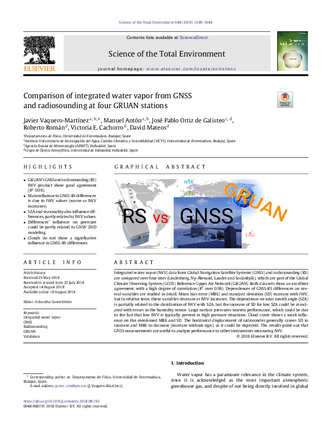Title
Comparison of integrated water vapor from GNSS and radiosounding at four GRUAN stations
Authors
Vaquero-Martínez, J., Antón, M., Ortiz de Galisteo, J. P., Román, R., Cachorro, V. E., and Mateos, D.
Published
by Science of the Total Environment (SotTE) at 2018-08-14
Abstract
Integrated water vapor (IWV) data from Global Navigation Satellite Systems (GNSS) and radiosounding (RS) are compared over four sites (Lindenberg, Ny-Ålesund, Lauder and Sodankylä), which are part of the Global Climate Observing System (GCOS) Reference Upper Air Network (GRUAN). Both datasets show an excellent agreement, with a high degree of correlation (R2 over 0.98). Dependences of GNSS-RS differences on several variables are studied in detail. Mean bias error (MBE) and standard deviation (SD) increase with IWV, but in relative term, these variables decrease as IWV increases. The dependence on solar zenith angle (SZA) is partially related to the distribution of IWV with SZA, but the increase of SD for low SZA could be associated with errors in the humidity sensor. Large surface pressures worsen performance, which could be due to the fact that low IWV is typically present in high pressure situations. Cloud cover shows a weak influence on the mentioned MBE and SD. The horizontal displacement of radiosondes generally causes SD to increase and MBE to decrease (increase without sign), as it could be expected. The results point out that GNSS measurements are useful to analyze performance to other instruments measuring IWV.
Citation
Vaquero-Martínez, J., Antón, M., Ortiz de Galisteo, J. P., Román, R., Cachorro, V. E., and Mateos, D.: Comparison of integrated water vapor from GNSS and radiosounding at four GRUAN stations, Science of the Total Environment, 648 (2019) 1639–1648, doi: 10.1016/j.scitotenv.2018.08.192
